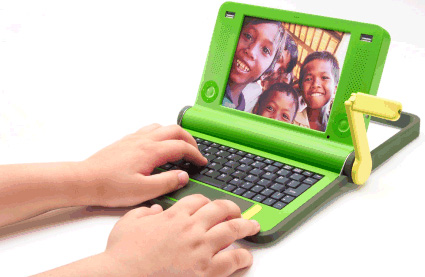Difference between revisions of "Werner"
| Line 1: | Line 1: | ||
== | ==The 100 dollar laptop== | ||
<br> | |||
<i>(editing currently in progress)</i> | |||
<br> | |||
The $100 laptop is an ultra-low-cost, full-featured computer designed to dramatically enhance children's primary and secondary education worldwide. It is the central project of the nonprofit One Laptop per Child (OLPC) association, which aims to equip the world's schoolchildren and their teachers with a personal, portable, connected computer. | |||
[[Image:laptop2.jpg]] | [[Image:laptop2.jpg]] | ||
Non-Profit Group 'One Laptop Per Child' | Non-Profit Group 'One Laptop Per Child' | ||
Proposed in January 2005 at the World Economic Forum in Davos, Switserland | Proposed in January 2005 at the World Economic Forum in Davos, Switserland | ||
Revision as of 17:32, 19 March 2006
The 100 dollar laptop
(editing currently in progress)
The $100 laptop is an ultra-low-cost, full-featured computer designed to dramatically enhance children's primary and secondary education worldwide. It is the central project of the nonprofit One Laptop per Child (OLPC) association, which aims to equip the world's schoolchildren and their teachers with a personal, portable, connected computer.
 Non-Profit Group 'One Laptop Per Child'
Proposed in January 2005 at the World Economic Forum in Davos, Switserland
Governments pay roughly $100 for the laptops and distribute them for free to students.
'Education Project, not a laptop project'
Grassroots movement;'Open Source Education' in line with Linux and Wikipedia
Wind-up Powered
Initiative of Nicholas Negroponte, co-founder of MIT Media Lab in collaboration with the UN
Targeted production; 150 milion per year
Thailand, China and India have expressed their interest
Non-Profit Group 'One Laptop Per Child'
Proposed in January 2005 at the World Economic Forum in Davos, Switserland
Governments pay roughly $100 for the laptops and distribute them for free to students.
'Education Project, not a laptop project'
Grassroots movement;'Open Source Education' in line with Linux and Wikipedia
Wind-up Powered
Initiative of Nicholas Negroponte, co-founder of MIT Media Lab in collaboration with the UN
Targeted production; 150 milion per year
Thailand, China and India have expressed their interest
The proposed design of the machines calls for a 500MHz processor, 1GB of memory and an innovative dual-mode display that can be used in full-color mode, or in a black-and-white sunlight-readable mode. The display makes the laptop "both an electronic book and a laptop," he said.
Power for the new systems will be provided through either conventional electric current, batteries or by a windup crank attached to the side of the notebooks, since many countries targeted by the plan do not have power in remote areas, Negroponte said.
The machines, which will run a version of the Linux operating system, will also include other applications, some developed by MIT researchers, as well as country-specific software. "Software has gotten too fat and unreliable, so we started with Linux," he said.
For connectivity, the systems will be Wi-Fi- and cell phone-enabled, and will include four USB ports, along with built-in "mesh networking," a peer-to-peer concept that allows machines to share a single Internet connection.
"In emerging nations, the issue is not connectivity," Negroponte said. "That was the issue, but there are many people working on it, (thanks to) global competitiveness. But for education, the roadblock is the laptop."
Five companies are working with MIT to develop an initial 5 million to 15 million test units within the year: Google, Advanced Micro Devices, News Corp., Red Hat and BrightStar, Negroponte said. He said the current plan is to produce 100 million to 150 million units by 2007.
While the initial goal of the project is to work with governments, Negroponte said MIT is considering licensing the design or giving it to a third-party company to build commercial versions of the PC. "Those might be available for $200, and $20 or $30 will come back to us to make the kids' laptops. We're still working on that," he said.
Steve Ballmer being first in proposing a $100 pc, only for different purposes;
Resources;